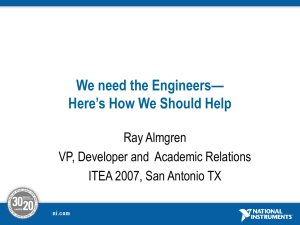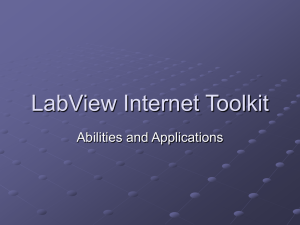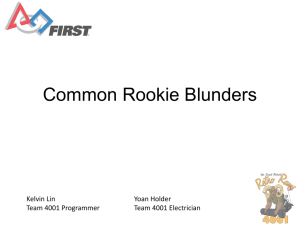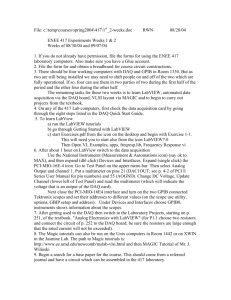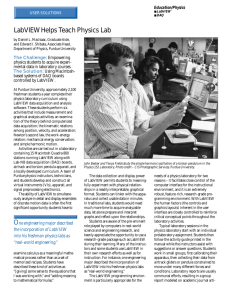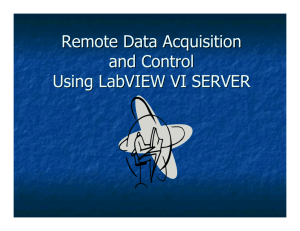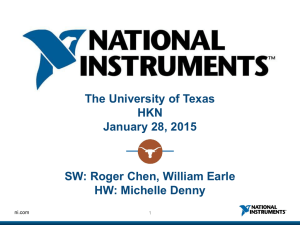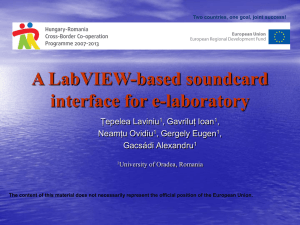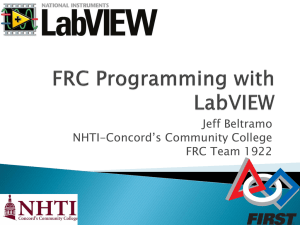MECH 391 Instrumentation
advertisement
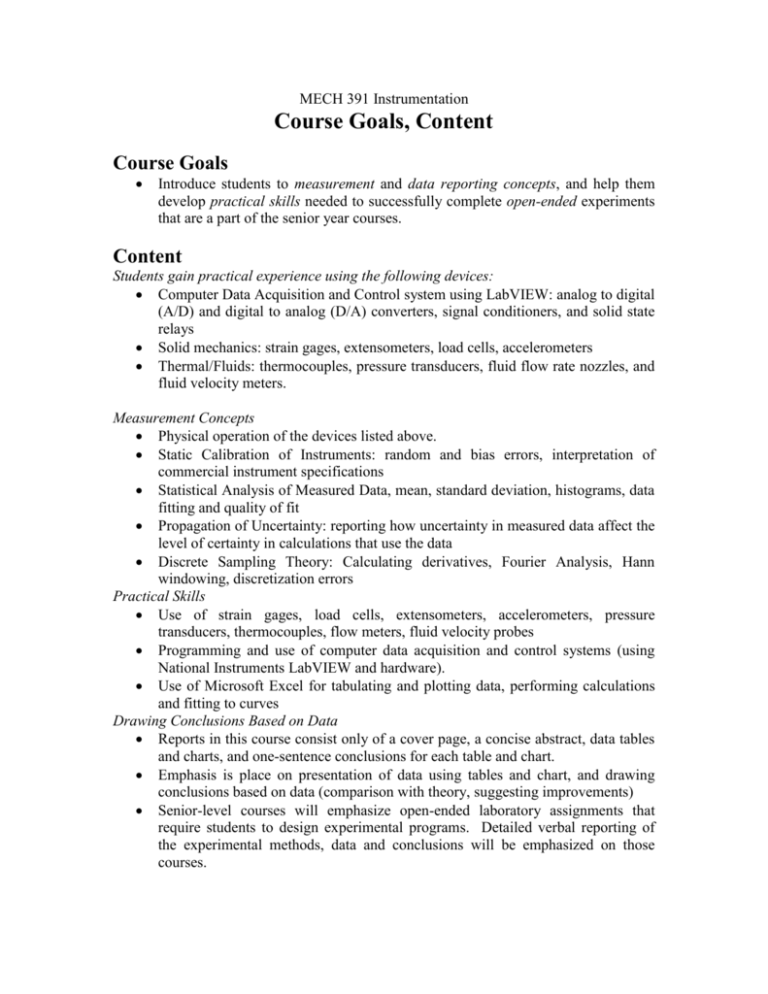
MECH 391 Instrumentation Course Goals, Content Course Goals Introduce students to measurement and data reporting concepts, and help them develop practical skills needed to successfully complete open-ended experiments that are a part of the senior year courses. Content Students gain practical experience using the following devices: Computer Data Acquisition and Control system using LabVIEW: analog to digital (A/D) and digital to analog (D/A) converters, signal conditioners, and solid state relays Solid mechanics: strain gages, extensometers, load cells, accelerometers Thermal/Fluids: thermocouples, pressure transducers, fluid flow rate nozzles, and fluid velocity meters. Measurement Concepts Physical operation of the devices listed above. Static Calibration of Instruments: random and bias errors, interpretation of commercial instrument specifications Statistical Analysis of Measured Data, mean, standard deviation, histograms, data fitting and quality of fit Propagation of Uncertainty: reporting how uncertainty in measured data affect the level of certainty in calculations that use the data Discrete Sampling Theory: Calculating derivatives, Fourier Analysis, Hann windowing, discretization errors Practical Skills Use of strain gages, load cells, extensometers, accelerometers, pressure transducers, thermocouples, flow meters, fluid velocity probes Programming and use of computer data acquisition and control systems (using National Instruments LabVIEW and hardware). Use of Microsoft Excel for tabulating and plotting data, performing calculations and fitting to curves Drawing Conclusions Based on Data Reports in this course consist only of a cover page, a concise abstract, data tables and charts, and one-sentence conclusions for each table and chart. Emphasis is place on presentation of data using tables and chart, and drawing conclusions based on data (comparison with theory, suggesting improvements) Senior-level courses will emphasize open-ended laboratory assignments that require students to design experimental programs. Detailed verbal reporting of the experimental methods, data and conclusions will be emphasized on those courses. Format 3 units (12 hours/week). One three-hour laboratory experience, two one-hour lectures, and one four-hour homework assignment per week Twelve well-defined labs during the term, performed in groups of two. All measurements are preformed, analyzed and reported during the three-hour lab period, with the help of lab instructors. Visit one local industrial test facility (Ebara International, which builds and tests large cryogenic petroleum product pumps). Lectures and homework are designed to prepare students for the lab assignments. One midterm and one final exam (in the future, replace final by a lab practicum) Website for downloading lab manual, lecture handouts, homework solutions, sample Excel workbooks and LabVIEW virtual instruments, and example lab reports. Will also be used to upload lab data reports. Lab Schedule Week Current Lab (2002) 1 1. Measure UNR Quad Area 2 2. Analyze UNR Quad Area, Excel Tutorial 3 3. Bourdon Tube Pressure Gage Calibration 4 5 4. Strain Gage Installation 5. Elastic Modulus Measurement 6 7 6. Instron Tester 7. Data Acquisition 8 8. Temperature of Boiling Water in Reno 9 10 Midterm 9. Boiling Water Heat Transfer Spring Break Spring Break 11 Field Trip: Ebara International 12 10. Hot Film Probe Calibration 13 14 11. Von Karmon Vortex Street 12. Temperature Control 15 Final Future Lab (2004) 1. LabVIEW Programming1 (Tutorial on front and back panel, programming interface) 2. Function Generation Using LabVIEW (sinewave, sawtooth, square, oscilloscope) 1 3. Data Acquisition Using LabVIEW (Derivatives, Fourier Analysis2, Hann windowing2) 4. Strain Gage Installation 5. Elastic Modulus of an Aluminum Beam using LabVIEW 6. Vibrations using LabVIEW1 7. Electronic Pressure Transducer Calibration using a Manometer1 8. Hot Film Probe Calibration using a Pitot Probe and Flow Nozzle Midterm 9. Von Karmon Vortex Street Frequency using LabVIEW Spring Break Field Trip: Ebara International 10. Temperature of Boiling Water at an Elevation of 4500 ft using LabVIEW 11. Transient Heat Transfer in Boiling Water using LabVIEW 12. Proportional Temperature Control using LabVIEW Final 1New Lab 2New Content Future Plans Eliminate course prerequisites and move to the sophomore year (MECH 291). This will improve retention of mechanical engineering juniors. However, it will require more lab sections to be offered (more TA support) or more laboratory stations because there are many more sophomores than juniors. Offer as a service course to other UNR undergraduate majors that require measurement experience (will require more TA’s and/or equipment) Offer to local industry (will require lectures to be offered at Noon, and an evening Laboratory Section). Recourses $4000/year to replace broken and outdated computers, and replenish supplies (thermocouples, strain gages, pressure transducers, heaters, solid state relays, signal conditioning hardware) One time $13,000 investment to replace outdated computers and construct a new small-scale wind tunnel (and a shake table for a vibrations experiment) Two graduate teaching assistant (In the future, use one graduate TA and one undergraduate tutor who has taken MECH 391 in the past. The tutor could be compensated by a combination of pay and MECH 499 credit) One course release for the professor in charge in order to design new lab experiences, write lab handouts, train teaching assistants, purchase supplies and construct new equipment (in addition to preparing and presenting lectures)
